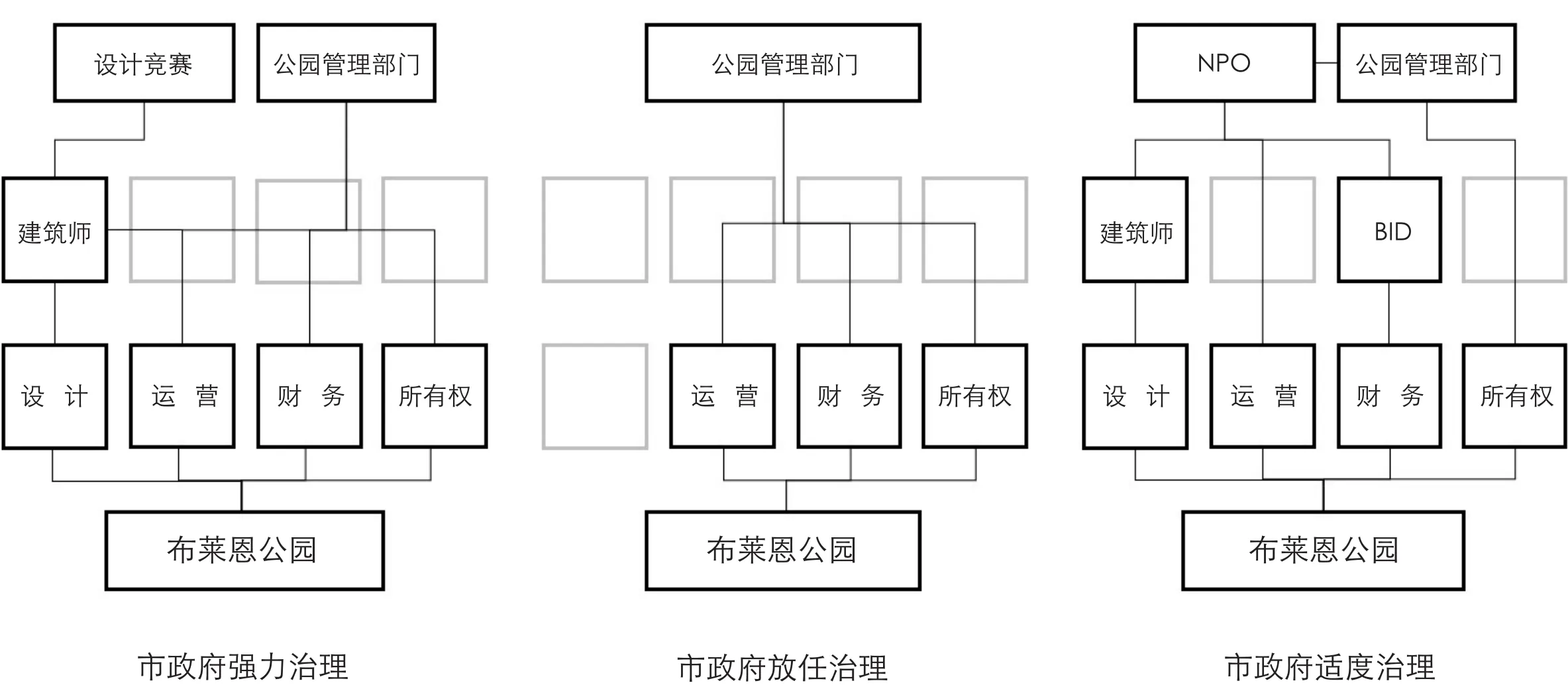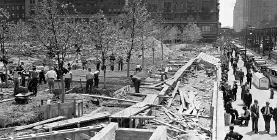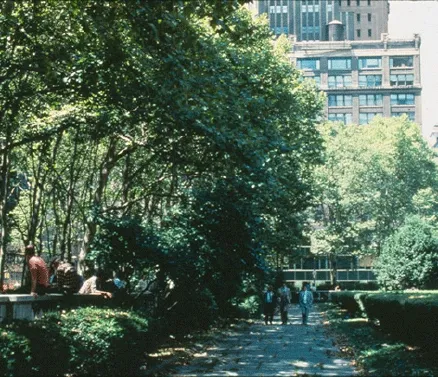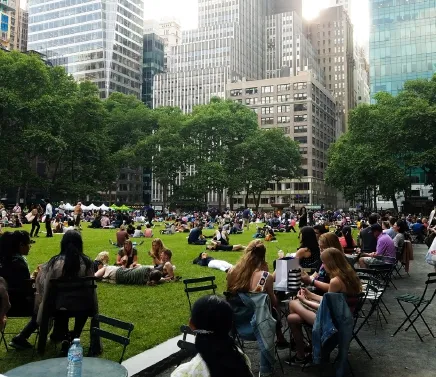纽约布莱恩公园百年变迁中的市政府角色
冉 展 朱文一
1 概 述
位于纽约中城区的布莱恩公园(Bryant Park)在纽约公共空间体系中扮演着非常重要的角色。与纽约中央公园不同,布莱恩公园以小而精的体量和半人工的自然环境为高密度的城市核心空间提供了喘息。公园中常年举办的各种丰富多样的活动、良好的设施和城市核心区稀缺的草坪、林荫等自然元素吸引了大量附近的居民、上班族和来自世界各地的游客在此休憩、游玩和参与活动,也使其被誉为纽约的“城市广场”(Town Square) 。
布莱恩公园的历史最早可以追溯到1686年时任纽约省殖民地长官的托马斯·唐根(Thomas Dongan)在纽约郊外划定的一块公共用地。在很长的一段时间内,这片公共用地被用作贫民的公墓。19世纪晚期,在经历过作为水库广场、世界工业博览会水晶宫场址等功能后,它从1884年起为纪念社会改革家威廉·卡伦·布莱恩特(William Cullen Bryant)被命名为布莱恩公园并沿用至今。在百年多的历史中,布莱恩公园经历过20世纪30年代和70年代的两次衰落,并在两次较大的空间改造后才最终成为如今活跃的城市公共空间。
公园是城市公共空间中的一种重要类型,是体现城市公共性的重要标志。在西方城市土地私有的背景下,公园作为以税收建设的公共资产,更能够体现其公共性。在塑造公共性的过程中,多方面的影响因素都起到了各不相同的作用,这其中不仅有公园的设计者,同样还有来自市政府权力的治理。布莱恩公园的百年历史,为我们从市政府管理的视角探寻这种影响机制提供了很好的范例。本文希望在布莱恩公园百年的历史中,以市政府管理的视角,从多治理时期、放任治理时期到适度治理时期3个阶段和3种方式入手(图1,图2),来剖析和揭示布莱恩公园空间演变背后的影响机制,并为当下我国城市公共空间建设管理带来启发。

图1 / Figure 1市政府治理类别Category of government governance来源:作者自绘
2 市政府强力治理时期(1933年—1950s)
1934年布莱恩公园的重大改造是市政府强力治理的代表性事件。20世纪30年代由于其紧邻的第六大道上高架铁路的兴建和拆除与地下化,布莱恩公园长时间被作为建筑材料堆放场地。在工程结束后,为了拯救和提升这片城市中难得的公共空间品质,纽约市政部门在1934年对布莱恩公园进行了第一次大规模改造。
在这次改造过程中,布莱恩公园从原先的维多利亚式椭圆形草坪、自由曲线型路径的空间形态被改造成了法国鲍扎体系(Beaux-Arts)风格控制下的中轴对称、规整正交的形态(图2a,图3,图4)。改造后的公园拥有一个两侧种植树篱的矩形大草坪,草坪四周规整地种植了成排的法国梧桐树,形成林荫小道。公园整体标高被抬高,三面由高出街面近一米的石墙围合,另一面则紧邻纽约公共图书馆。公园与街道之间只由有限的几个狭窄陡峭的楼梯连接。这次改造构成了布莱恩公园在今后近90年的主要空间形态。
1934年的改造是由时任纽约公园专员的罗伯特·摩西(Robert Moses)主导的,而改造的契机则源于1933年举办的一次建筑设计竞赛。在20世纪30年代经济危机的背景下,纽约市建筑师自发组织的“建筑师紧急委员会”举办了一次针对当时凋敝的布莱恩公园的改造设计竞赛。来自纽约皇后区的卢比·辛普森(Lusby Simpson)和摩西的朋友景观建筑师吉尔莫尔·克拉克(Gilmore Clarke)赢得了这次竞赛。在这次竞赛的次年,摩西上任成为了纽约的首任公园专员,并借助大萧条过后逐渐恢复的建设,运用其出色的政治运作获得了罗斯福新政实施资金,发起了一大批公共设施的建设改造,其中布莱恩公园就在这批上任首年发起的项目之中。
摩西的个人色彩鲜明地体现在公园的建设过程中,纵使布莱恩公园在其大批的建设项目中并非最重要的部分,他仍然对公园的设计和建造进行了细致的把控。摩西在施工阶段人事任命、场地总体利用与设计、植物种植方式、场地通达性等几个方面把控了设计。具体建设过程中,摩西将建筑师更换为颇受其信任的艾玛·安伯利(Aymar Embury II) 和吉尔莫尔·克拉克(Gilmore Clarke)。 公园的本次改造建设是在第六大道铁路地下化,将公园作为渣土和材料堆放地之后,场地上遗留了大量修建地下铁路挖出的渣土,摩西要求保留场地上的渣土,使得本次改造后布莱恩公园高出了街道人行道标高。同时摩西要求除了场地保留的有限出口之外,将整个公园用铁篱和高大的树篱与城市隔离开,仅仅保留了5个狭窄陡峭的、与街道相连的楼梯。这样的干预与操作与摩西本人对城市公园建设的态度有着很大的关系,他将城市中的公园视作高楼森林中被切割出的避难地,也因此在某种程度上希望将公园与城市的日常功能进行不同程度的隔离。

图2 / Figure 2布莱恩公园百年发展历程Hundred-years' vicissitude of Bryant Park
摩西是市政府强力治理的代表性人物,他是纽约20世纪30年代到60年代在城市建设和公共空间营造方面极为重要的权威。在其职业的高峰期,他同时兼任了十数项纽约城市建设和公园规划方面的职务。他虽然从来没有成为纽约市长,但是其权力覆盖范围之大、时间之长,已经成为纽约城市公共建设的“凯撒”式的人物。摩西之所以能够取得如此空前绝后的权力地位,与其工作方式不无关系。“他总是确保呈现给他的项目细节都被他一一审视,也同样确保项目所有的细节都能够被呈现给他……摩西对自己的要求是他必须把控目力所及的一切,无论这些事情在别人眼中有多么琐碎或无关紧要1”。摩西严格地要求一切他所能把控的最细小的细节都被完成到他所认定的完美标准,并且这样的要求带有非常鲜明的个人主观色彩。这样的工作方式也反映在其任下纽约公共空间塑造的过程中,类似布莱恩公园一样在规划、设计和实施阶段被摩西的个人偏好与意志留下烙印的项目比比皆是,给纽约留下了被评价为“为白人中产阶级意识形态服务的” 长岛公园大道体系、开放公园空间和连接纽约各区域的众多高速公路和桥梁,构成了如今纽约公共空间体系的骨架网络。
3 市政府放任治理时期(1970s—1980s)
20世纪70年代初的布莱恩公园面临着严重的危机。公园的日常使用缺乏维护,而高大树篱和有限入口加剧了与城市街道隔离的状态,则为各种犯罪活动提供了温床。布莱恩公园成为城市中心掩护毒贩与性交易的“绿洲”,人们甚至称之为“针尖公园”(图2b),暗指泛滥的毒品交易与瘾君子的聚集场所。这样的非法活动甚至在白天都存在,使得周边的居民与业主对这个公园避而远之。
犯罪活动来自于公园与城市极其有限的视线和动线连接,以及公园内部以高大树篱进一步与外界分隔的草坪。这样有限的可达性与视线联系导致公园内部发生的活动几乎不会受到外界的影响与监视,为需要隐蔽环境的犯罪活动提供了极佳的生存条件。另一方面,摩西时代的公园空间形态并不适合多样性活动的开展,公园内部缺少能够吸引人参与的活动类型,更加加剧了公园与城市活动和市民参与的隔离。

图3 / Figure 31934年改造前的布莱恩公园 / Bryant park before 1934 restoration / 来源/Source:http://blog.bryantpark.org/2012/04/20th-anniversary-bryant-park-in-1930s.html

图4 / Figure 41934年改造中的布莱恩公园 / Bryant parkd during 1934 restoration / 来源/Source:http://blog.bryantpark.org/2012/04/20th-anniversary-1934-bryant-park.html
在多种因素的影响下,这一时期的纽约市政府与公园管理部门对布莱恩公园的治理处于放任状态。一方面,20世纪70年代美国整体的经济处于“滞涨”阶段,市政府财政收入随着经济增长的停滞而下滑,财政赤字扩大,市政府难以负担公共服务的开销,进而导致应有的维护、治安等公共服务缺乏。这一时期的纽约市政府甚至一度陷入到破产的危机中,时任纽约市长的亚伯拉罕·比姆(Abraham Beame)疲于应付城市的财政危机,无暇顾及并非核心的城市公园建设与维护。其任下的公园专员也不断更换,从1973年到1978年,市政府更换了5任公园专员,其中任期最短的仅仅3个月。这样高频率的执政者更迭也使得公园部门缺乏稳定的业务建设环境。总的来说,资金的缺乏和稳定的管理环境的缺失,使得这一时期布莱恩公园的直接管理者——纽约市公园部门对其极少进行修缮、维护等,从而放任了公园的逐渐堕落。
市政府放任治理状态下的布莱恩公园陷入了恶性循环。1978年前的布莱恩公园彻底成为了城市中犯罪的温床,其后接手公园专员职位的戈登·戴维斯(Gordon Davis)甚至曾考虑拆除布莱恩公园,以制止其对城市带来的负面影响2。
4 市政府适度治理时期(1980s至今)
1988年到1992年,布莱恩公园的修复更新计划是市政府适度治理公共空间塑造过程的典型案例。在经历了20世纪70至80年代的萧条后,布莱恩公园凋敝的状态引起了周边业主和市政府的关注。在一系列努力后,本次更新修复从1988年持续到了1992年,一方面将公园抬高部分的地下建设成为其相邻的纽约市公共图书馆的地下书库,另一方面则拆除了导致公园与城市隔离的高大树篱和铁栅栏,拓宽并增加了公园与城市连接的出入口,将公园原本的狭窄陡峭楼梯改造成拥有巨大面宽和缓和梯步的宽大台阶,添设了各式城市家具和公园设施。这些对公园的更新改造让布莱恩公园焕然一新(图5—图7),并使之得到了周边业主和城市居民、游客的日益喜爱,让其成为了如今纽约重要的公共空间(图8)。
时任纽约公园专员的戈登·戴维斯(Gordon Davis)是本次改造更新政府方面的主要推动者,他以引入新成立的布莱恩公园修复公司(BPRC)的方式,较为适度地推进布莱恩公园的修复更新过程。本次改造初期,布莱恩公园糟糕的状况引发了其相邻的纽约公共图书馆的担忧,图书馆的董事会提出了针对公园进行改造的动议,得到了公园专员戴维斯的支持。在纽约图书馆信托的推动、市政府的支持下,图书馆信托捐赠者、时代公司主席安德鲁·海斯克尔(Andrew Heiskell)协同洛克菲勒兄弟基金会共同成立了布莱恩公园修复公司。戴维斯则支持并帮助该公司以象征性的价格获得了公园的使用和运营权,而公园的所有权则仍然归属纽约市政。他通过引入第三方私人机构,提供了一种市政府适度治理公共空间塑造的方式,即保持对空间属性和发展方向的把控,但在具体细节的设计和运营上则交由民间机构进行决断。

图5 / Figure 520世纪80年代的布莱恩公园Bryant Park in the 1980s来源/Source:http://blog.bryantpark.org/2014/06/from-archives-bryant-park-before-and.html

图6 / Figure 62014年与图5同一角度的布莱恩公园Bryant Park in 2014 at the same view as fi gure 5来源/Source:http://blog.bryantpark.org/2014/06/from-archives-bryant-park-before-and.html
在随后的四年内,布莱恩公园修复公司帮助布莱恩公园发展成为如今的兴盛面貌。布莱恩公园修复公司在丹尼尔·毕德曼(Daniel Biederman)负责下,聘用了景观设计师汉娜·奥林(Hanna / Olin Ltd.)和事务所HHPA(Hardy Holzman Pfeiffer Associates)对公园进行了重新设计。同时采纳了威廉·怀特(William H. Whyte)的想法,通过放置可移动的城市家具、增加城市通达性等方式,更新了布莱恩公园的物理空间形态。
改造后的公园不仅增加了公园与城市的视线沟通、减少了与城市的物理隔离,还通过完善维护、增加公园设施的方式吸引公园人气。改造后的布莱恩公园添置了大量可移动的椅子(图9),修缮并开放了长期关闭的公园洗手间,增加了旋转木马、咖啡屋、书报亭等公用设施,并在公园举办活动期间由志愿者提供存包等服务。在公园的日常运营上,举办了读书会、电影夜、瑜伽课程等各式针对不同目标人群的活动(图10,图11)。而这些变化和决策的背后,则是对丹尼尔有着深远影响的美国公共管理学家詹姆斯·威尔森(James Q Wilson)所提出的破窗理论。丹尼尔认为,要改善布莱恩公园在70年代所遭遇的颓丧境遇,需要始终保持对公园的高水平维护与利用,降低出现由于缺乏维护、环境不整洁等小型管理滑坡诱导的犯罪滋生等严重衰退情况发生的可能性。
在公园的财务运营上,布莱恩公园公司引入了布莱恩公园商业促进区(BID)参与负责公园日常运营开销,通过提升公园运营品质和提供多样化的活动,来激活周边产业的发展与物业价值的提升,进而反馈为商业促进区业主的利润,形成一个非盈利运营机构的正向循环发展(图12)。改造完成后的布莱恩公园修复公司更名为布莱恩公园公司(BPC),负责公园的运营,发挥了一个非盈利民间机构的高效与灵活性,为公园提供了多种多样的季节性、亲民化的活动,取得了巨大的成功。
戴维斯的政策提供了一种新的市政府适度治理城市公共空间塑造的样例。通过把控市政府在公共空间改造过程中的参与面和参与程度,为第三方参与者创造了更多自由灵活发挥的空间,从而多样化了空间塑造的可能性。这样的适度治理方式能够为城市公共空间塑造提供更多的可能性,也相应的能塑造出更多更为成功的城市公共空间。

图7 / Figure 71988年改造后的布莱恩公园Bryant park after1988 restoration来源/Source:https://bryantpark.org/programs

图8 / Figure 8广受市民和游客欢迎的布莱恩公园Bryant Park, popular with citizens and tourists来源:冉展 摄 / Source: RAN Zhan
5 结 语
从纽约布莱恩公园跌宕起伏的发展过程中可以发现,市政府治理的程度在城市公共空间塑造变迁的过程中有着重要的影响。市政府不同治理程度下的布莱恩公园呈现出了截然不同的面貌,强力治理政府管理建设下的公园能够快速完成复兴和发展,却由于缺乏灵活性和后续的精细管理,在部分时代背景的影响下成为放任治理后市政府管理后失败的源头。适度治理的市政府管理则为公园提供了一种新的发展方式,引领其成为如今纽约成功的重要城市公共空间之一。在公共空间塑造的过程中,对空间最终品质产生影响的并不局限于传统认为的空间直接设计者和运营者,同样还包括监管、指导空间发展运营的城市行政机构。市政府治理在空间设计的方向把控、设计人事的任命、管理方式的确立等各方面都拥有可以扮演的重要角色,并对空间的最终发展产生深远影响。
布莱恩公园变迁所揭示的市政府治理程度对公园,以至城市其他公共空间塑造的影响机制,对界定市政府在城市空间塑造过程中的治理程度有着重要的启示意义。通过总结布莱恩公园发展的变迁,可以认为,市政府以适度治理的方式参与到城市公共空间的建设管理中,能让公共空间拥有更大的发展可能性。市政府把控公共空间的发展方向与各项权利的分割和界限,结合专业从业者进行更高效灵活的具体设计与运营,可以使公共空间得到理想的发展效果和最大化的使用效率,从而为城市塑造更美好的公共空间。
今天,中国城市正处在追求城市空间品质提升的关键转型阶段。城市公共空间是体现空间品质的重要元素。市政府治理角度下的布莱恩公园发展历程对中国城市公共空间塑造有着有益的借鉴价值。
注释
Notes
1 引自Lewis, E. (1980). Public entrepreneurship: Toward a theory of bureaucratic political power: The organizational lives of Hyman Rickover, J. Edgar Hoover, and Robert Moses. Bloomington, IN: Indiana University Press.
2 源自纽约时报1978年1月10日Parks to him are city's gem.

图9 / Figure 9布莱恩公园的可移动城市家具Movable public furniture in Bryant Park来源/Source:http://blog.bryantpark.org/2014/06/from-archives-bryant-park-before-and.html

图10 / Figure 10冬季活动期间的布莱恩公园Bryant park during winter public event来源/Source:https://bryantpark.org/?/blog/bank-of-america-winter-village-to-open-october-27
The Role of Municipality in the Vicissitude of Bryant Park in New York
RAN Zhan, ZHU Wenyi
Bryant Park plays a very important role in New York's public space system. After experiencing two declines, and two major transformations, it finally became an activated urban public space.
Parks are important symbol of publicity in cities.When shaping publicity, various factors played a role,not only the designers, but also the municipality's governance. This paper hopes to analyze the in fl uence on public space from the perspective of municipal governance (Figure 1) and thus bring inspiration.
The transformation of the park in 1934 was an archetype of municipality's strong involvement. During this renovation, Bryant Park has been transformed from the original Victorian form (Figure 2) to the French Beaux-Arts style (Figure 3). The height of the park was raised and the park has limited access to the street.
The 1934 transformation was led by Robert Moses,the then New York Park Commissioner. After taking up as New York Park Commissioner, Moses used his political skills to carry out series of public space renovation projects, including Bryant Park. (Figure 4). Moses' personality is vividly reflected in these designs. He intervened the design in the aspects of personnel appointment, site utilization, planting methods, and site accessibility. Moses replaced the architect winning the restoration competition with his own men; he requested to retain the muck on the site. The entire park was required to use fences and tall hedge to isolate itself from the city. Such governance has a lot to do with Moses' attitude towards urban park.Moses regards the park in the city as a refuge in the dense urban area, and therefore hoped to separate the park and the city.
The park in the early 1970s faced a serious crisis. On the one hand, the lack of maintenance in the park,and the isolation from city due to hedges and limited access provided a hotbed of criminal activity. On the other hand, the park's spatial form which was not suitable for the diverse activities, led to the decline of users and intensi fi ed the state of isolation.
During this period, the New York City government had little involvement in the management due to various factors. On the one hand, the overall economy of the United States then was in “stag fl ation” stage, and the municipal government could not afford public services, causing the lack of sanitation and police force.On the other hand, the park commissioner in New York was also constantly changing in that period. In general, the lack of funds and stable management environment made it impossible for the administrator to intervene, and fi nally led to the fall of the park.

图11 / Figure 11布莱恩公园的夏日电影夜Movie night in Bryant Park来源/Source:http://blog.bryantpark.org/2011/06/ fi lm-festival-know-before-you-go.html

图12 / Figure 12布莱恩公园商业促进区Bryant park business improvement district来源/Source:https://www1.nyc.gov/site/sbs/neighborhoods/bid-directory.page?bid=8
The restoration of the park from 1988 to 1992 was a typical case of modest governance by the municipal government. After the down time, the state of the park has caused concern from the surrounding estate owners and the municipality. After a series of efforts, the restoration carried out, with the removal of the hedges and fences, widening and adding the entrance. A variety of furniture and facilities have been installed.These renovations to the park have given Bryant Park a new look (Figures 6, 7, 8) and made it an important public space in New York today (Figure 9).
Gordon Davis, the New York Park Commissioner then, was the main promoter of the renewal from the government side. He introduced the newly established BPRC as a modest governing method in the restoration process. Davis supported BPRC to gain access of the operation control of the park at a nominal cost. In the next four years, BPRC helped the park grow to its current prosperity. The renovated park has improved the connection with the city and attracted the park's popularity through good maintenance and increased park facilities. In the daily operation of the park, various activities for different target groups were held (Figures 11, 12). Behind these change decisions is the “broken window” theory proposed by American public management scholar James Q.Wilson, who has a profound in fl uence on Daniel. In the fi nancial operation of the park, Bryant Park Company introduced BID to participate in the fi nancing of the park, and by increasing the quality of the park, it brought value to the surrounding properties and then fed back to BID's pro fi t (Figure 13).
Davis's approach to govern provides a new example of a city government's modest involvement in the shaping of urban public spaces. By controlling the participation of the municipal government in the process of public space transformation, more space is created freely and flexibly, and the possibility of space shaping is diversi fi ed.
The in fl uence mechanism of the involvement of the municipal government in the change of the Bryan Park on the shaping of the public space has important implications for us to define the degree of governance of the municipal government in the process of shaping the urban space. The author believes that the municipal government should intervene in a moderate manner, by controlling the development direction of the public space, and let professionals to do design and operation, and maximize the effectiveness and ef fi ciency, thus shaping a better city public space.

